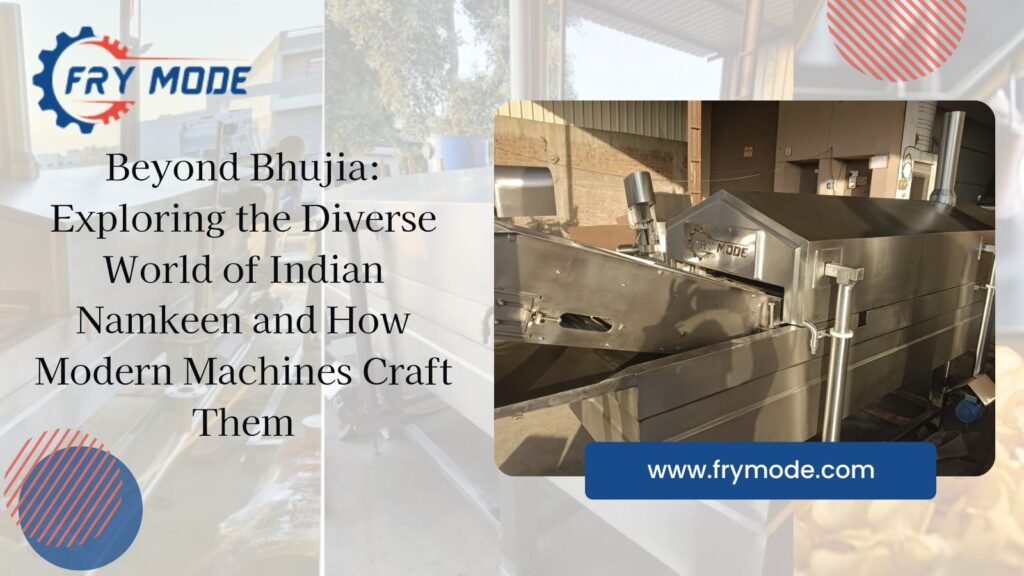Beyond Bhujia: Exploring the Diverse World of Indian Namkeen and How Modern Machines Craft Them
Introduction: The Evolution of Namkeen—From Region to Revolution
India doesn’t snack quietly. We crunch, munch, and spice things up with namkeen—a broad term for our desi savoury snacks. Each region has its own flavorful take, and today’s demand isn’t just local, it’s global.
But how do manufacturers keep up with such variety? That’s where modern namkeen machines step in. In this blog, we dive into the colorful world of Indian snack varieties and the tech that brings them to life on a commercial scale.

1. A Snack for Every State: Types of Namkeen You Should Know
Let’s break down some of the most beloved namkeen types in India:
- Bhujia (Rajasthan): Thin, crispy chickpea flour strands spiced to perfection.
- Chakli / Murukku (Maharashtra & South India): Spiral-shaped crunchy rice & urad dal flour snack.
- Farsan Mix (Gujarat): A savoury medley of sev, papdi, gathiya, and peanuts.
- Aloo Bhujia (North India): Potato-based snack with tangy seasoning.
- Kara Boondi (South India): Fried chickpea flour droplets, often used in mixtures.
- Shakkarpara / Namakpara (Pan-India): Sweet or salty fried dough bits.
Every snack has its own texture, thickness, seasoning style, and frying requirement—which makes the production process quite complex.
2. The Challenge: Traditional Snacks Meet Modern Demand
The taste of traditional namkeen is sacred to consumers. However, hand-made batches can’t match today’s volume requirements. That’s where snack production machinery becomes essential.
Key problems that machines solve:
- Inconsistent shapes and sizes from manual extrusion
- Labor-intensive frying and seasoning
- Inefficient packing and hygiene concerns
Modern machines allow producers to scale without losing authenticity.
3. How Modern Machines Craft Regional Namkeen with Precision
Each variety demands a slightly different setup, and that’s where customizable machines come in.
- Namkeen Extruders: Equipped with interchangeable dies to create sev, bhujia, gathiya, or even custom snacks.
- Batch & Continuous Fryers: Control temperature and oil circulation precisely to suit different snack types.
- Flavor Mixers & Coating Drums: Adjust seasoning uniformly, no matter how delicate or complex the blend.
- High-speed Packing Machines: Preserve freshness and increase shelf life, especially for exports.
With this modular approach, snack makers can produce multiple types of namkeen with one integrated line.
4. Popular Namkeen Varieties Now Made at Scale
Here are some popular Indian namkeen snacks that are being produced commercially using machines:
| Namkeen Variety | Machine Required | Production Type |
|---|---|---|
| Aloo Bhujia | Potato processing + extruder + fryer | Semi-auto to auto |
| Gujarati Farsan Mix | Multi extruder + fryer + coating drum | Fully automatic |
| Boondi | Circular fryer with mesh system | High speed batch |
| Chakli / Murukku | Heavy-duty extruder + die set | Semi-auto |
| Namakpara / Shakkarpara | Dough sheeter + cutter + fryer | Semi-auto to auto |
5. Why This Matters: Consumer Trends & Export Opportunity
Indian namkeen is no longer just a local treat. With increasing exports to the USA, UK, and the Middle East, consistency, hygiene, and volume have become non-negotiable. Machines help you:
- Meet international food standards
- Scale up for large orders
- Standardize recipes for franchise or retail chains
The ability to replicate regional snacks in bulk is a competitive edge.
Namkeen is more than just a snack—it’s culture in a packet
At Frymode, we help Indian snack brands and manufacturers bring regional taste to the global stage with precise, powerful machines made right here in India. Let’s build your snack line today.
Conclusion: A Future Full of Flavour & Opportunity
India’s snack heritage is rich, regional, and rapidly growing in demand. As a food business owner or manufacturer, tapping into this demand requires more than just recipes—it needs reliable, modern machinery that respects the art of traditional namkeen while upgrading it for scale.
With the right equipment, you can produce multiple varieties, meet hygiene standards, and delight customers across geographies with authentic taste and consistent quality.
